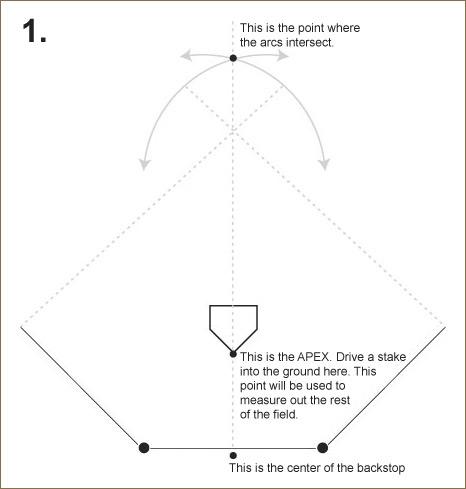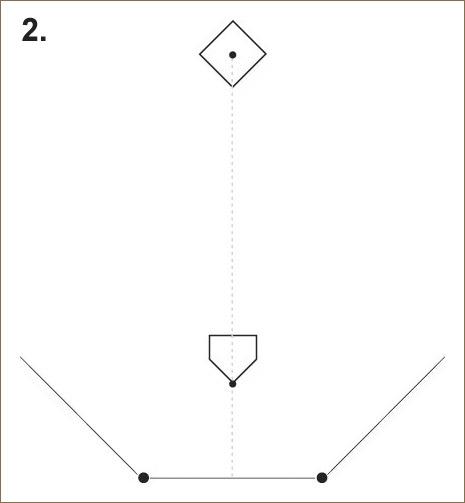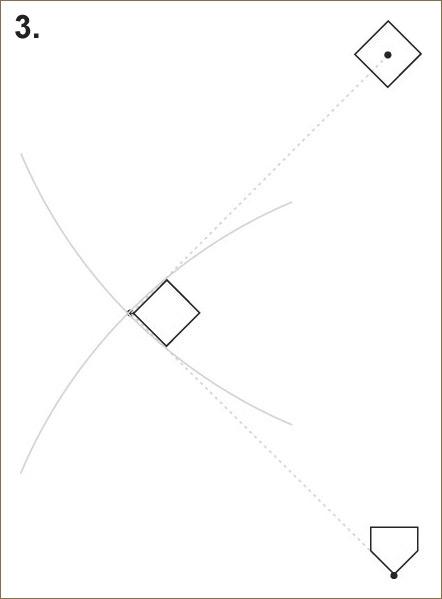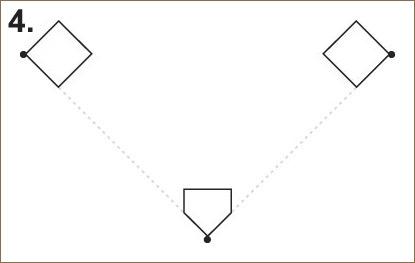How To Layout a Baseball Field
Field Orientation
Align the field so that the pitcher is throwing across the sunrise/sunset line.
Step 1: Triangulate the Backstop
If there is no backstop, position the apex of home plate in an appropriate spot. For positioning the apex of home plate using an existing backstop, start from one outside corner of the backstop and run a string or tape measure out to a couple of feet past where you think the pitching rubber will be. Scribe an arc. Repeat this process starting from the second post, making sure the second string or tape is the same length as the first.
Next, measure and locate the center of the backstop. Extend a straight line from this point out to where the arcs intersect. Position the apex of home plate on this line, and depending on which type of field, a prescribed distance from the backstop.
Recommended distance from backstop to apex:
20' for Shetland and Pinto League (50' Field)
20' for Mustang League (60' Field)
25' for Little League (60' Field)
30' for Bronco League (70' Field)
40' for Pony League (80' Field)
25' for Softball (60' Field)
60' for Baseball (90' Field)
Distance measured from apex of home plate to center of backstop.

Step 2: Locate Second Base
Run a line from the center point on the backstop, through the apex and over pitcher's mound to place second base on center. The distance to measure is from the apex of home plate to the center of second base.
Distance from apex to center of second base:
70' 8-1/2" for Shetland and Pinto League (50' Field)
84' 10-1/4" for Mustang League (60' Field)
84' 10-1/4" for Little League (60' Field)
84' 10-1/4" for Softball (60' Field)
99' for Bronco League (70' Field)
113' 1-5/8" for Pony League (80' Field)
127' 3-3/8" for Baseball (90' Field)
(These measurements are identical to the distance from the outside back corner of third base to the outside back corner of first base.)

Step 3: Locate First Base and Third Base
Measure the appropriate baseline distance to third base from the apex and scribe an arc. Measure the same distance from the center of second base to third base and scribe another arc. Place the outside back corner of the base where the arcs intersect. Repeat to locate first base.
Distance from apex and second base to first or third base:
50' for Shetland and Pinto League (50' Field)
60' for Mustang League (60' Field)
60' for Little League (60' Field)
60' for Softball (60' Field)
70' for Bronco League (70' Field)
80' for Pony League (80' Field)
90' for Baseball (90' Field)

Step 4: Set Home Plate
Draw a line from the outside back corner of third base to the apex and from the outside back corner of first base to the apex. Align the back angles of home plate to match up with these lines.

Watch this video on improving footing on your mound with just 8 Turface Moundmaster Blocks
Step 5: Set Pitching Rubber
Following the straight line from the apex to the center of second base, measure a line from the apex to the spot where the front of the pitching rubber will be. Square up the pitching rubber by measuring an equal distance from the front corners of home plate to the corresponding corners on the pitching rubber.
Distance from apex to front of pitching rubber:
35' for Shetland-Pinto-Mustang Softball (50' Field)
38' for Pinto Baseball (50' Field)
40' for Bronco Slow-Pitch Softball (60' Field)
44' for Mustang Baseball (60' Field)
46' for Pony-Colt-Palomino Fast-Pitch Softball (60' Field)
46' for Little League (60' Field)
46' for Softball (60' Field)
48' for Bronco League (70' Field)
54' for Pony League (80' Field)
60' 6" for Baseball (90' Field)
Measure and mark the proper distance of the pitching plate (rubber) from home plate. The pitching plate (rubber) is measured from the front edge and center of the pitching plate (rubber) to the APEX of home plate. The front edge of home plate is 17 inches in front of the apex. REMEMBER, THE CENTER OF THE MOUND IS 18" IN FRONT OF THE RUBBER ON A 90' FIELD. You can also use this technique to layout an infield in a gym, or in the outfield grass for practice.
